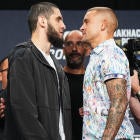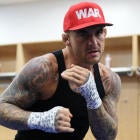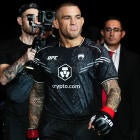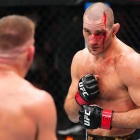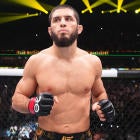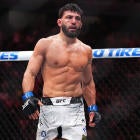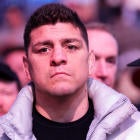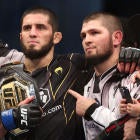Is the cage half empty, or half full?
Depending on your UFC perspective, there's ample evidence to support either claim.
The company just came off the most significant pay-per-view show in its history at the sparkling new T-Mobile Center in Las Vegas, and the presence of stars like Brock Lesnar and Anderson Silva on the card helped attract the celebrity likes of Tom Brady, Justin Timberlake and Rosie Perez.
It's never been more popular or mainstream, and the recent deal in which Zuffa LLC sold it to WME-IMG carried a price tag of $4 billion -- making it the largest such acquisition in sports history.
Not to mention a nine-figure cable deal with Fox that maintains a TV presence between big shows.
Still, if you're looking for issues, they're not hard to come by either.
Lest we forget, the 200 card's main event was scuttled by a Jon Jones drug test just days before Bruce Buffer's introductions, prompting late-stage shuffling that bumped a women's bout to top billing and necessitated the inclusion of Silva, whose fight-night performance was more hollow than heroic.
An even bigger bomb was dropped a few days later, when the story of Lesnar's failed drug test broke -- effectively ending the octagonal return of the WWE and PPV powerhouse before it began.
And all that came shortly after a tumultuous stretch in which reigning combat sports supernovas Conor McGregor and Ronda Rousey were knocked from their perches via jaw-dropping second-round stoppages. Rousey's bantamweight title has since changed hands two more times, while McGregor and Dana White followed up with a highly-publicized feud in which the Irishman retired to protest excessive media obligations, then grumbled when he was yanked from the 200 card's top spot.
He'll return with conqueror Nate Diaz to headline UFC 202, where a second straight loss would be cataclysmic for an organization relying on his star power to maintain connection with casual fans.
"We're confident that the new ownership team of WME-IMG, with whom we've built a strong relationship over the last several years, is committed to accelerating UFC's global growth," said outgoing chairman Lorenzo Fertitta, who, along with his brother, Frank, bought the company for $2 million. "Most importantly, our new owners share the same vision and passion for this organization and its athletes."
Perhaps the most ominous reality is that, beyond crossover megastars like McGregor, Rousey and Lesnar, the roster quickly drops off to a collection of fighters whose acumen is beyond rational debate - but whose name recognition beyond those fans already under the UFC tent is much less powerful.
A 29-year-old Lesnar -- his 30th birthday was a day later -- headlined the UFC's 100th pay-per-view show in 2007, and his presence for 200 remained a selling point nine years later. Jones was on the preliminary show that night as a 19-year-old and seemed destined to rejoin the others as primary standard-bearers, but his recent transgression - and the prolonged suspension it brings - makes that unlikely at best.
"Two years is going to kill him," noted trainer Freddie Roach told Sherdog.com. "I feel like it will be the end of his career."
Given Jones and Lesnar's troubles, McGregor and Rousey's vulnerability and the comparative anonymity of nearly everyone else, it becomes a touch more difficult to forecast where things might go by the time the next numerically monumental events - UFC 250 and 300 - reach the radar screen.
Thirty-seven months passed between the 100th and 150th shows, and another 47 months between 150 and 200, which means a conservative estimate for 250's arrival might be January 2020 while 300 is another three-plus years beyond that in July 2023.
Six of the UFC's eight male weight-class champions are already at least a year past their 30th birthdays, which leaves McGregor, 28, and flyweight title-holder Demetrious Johnson, 29, the most likely candidates to still be near peak form that far down the line. Likewise, the two reigning women's champions - strawweight Joanna Jedrzejczyk and bantamweight Amanda Nunes - are each 28, which provides them a chance to play a role if both they, and the women's side as a whole, stay relevant.
Outside of them, it'll be up to White and Co. to mine for young talent that'll have enough time to be entrenched by the time the mega-shows arrive.
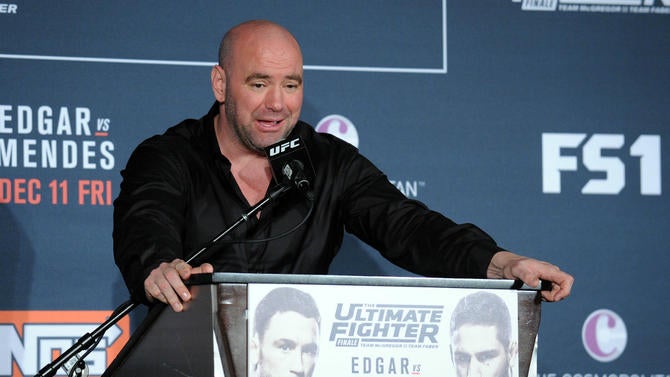
Welterweight Kelvin Gastelum, who won't be 25 until October, earned rave reviews for a defeat of former champion Johny Hendricks on the UFC 200 undercard and probably leads the pack when it comes to forecasting guys who'll be front and center a hundred shows from now. After him, it's 26-year-old bantamweight John Lineker, who stopped another youngster - 25-year-old Michael McDonald - in the first round of their UFC Fight Night bout last week and earned a Performance of the Night nod.
And featherweight Max Holloway, who went three rounds with McGregor as a 21-year-old, is still just 24 and has won nine in a row since - including a decision over Ricardo Lamas at UFC 199.
If you're looking to lay a futures bet, any of those would provide a handsome payoff.
Meanwhile, the overwhelming success of live shows in Australia and Brazil bodes well for international expansion, which White has long said is on the agenda and which could also go a long way toward continuing the grow the sport even as it struggles to refill the talent pipeline domestically.
Not surprisingly, the boss is bullish on the possibilities.
"No other sport compares to UFC," he said. "Our goal has always been to put on the biggest and the best fights for our fans, and to make this the biggest sport in the world. I'm looking forward to working with WME-IMG to continue to take this sport to the next level."












